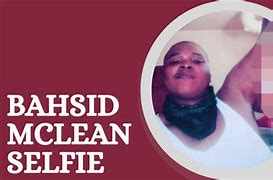Bahsid McLean Selfie The digital age has brought about a significant transformation in how news spreads and how the public consumes it. Social media platforms, with their ability to disseminate information instantly, have become integral to this change. However, these platforms have also given rise to the phenomenon of “viral content,” where shocking, sensational, or bizarre stories can capture global attention within hours. One such disturbing case that shook the internet was that of Bahsid McLean. His name became infamous not just for the heinous crime he committed, but also for a grotesque selfie that he took, which became emblematic of his lack of remorse.
The Crime Bahsid McLean Selfie
In February 2013, the world was introduced to a crime that would leave many horrified. Bahsid McLean, a 23-year-old man from the Bronx, New York, was arrested for the brutal murder of his mother, Tanya Byrd. The details of the crime were gruesome: McLean had killed his mother, dismembered her body, and then scattered the remains around their neighborhood in an attempt to conceal his crime. Bahsid McLean Selfie This act alone was enough to shock the public, but what followed turned the case into a media sensation. Bahsid McLean Selfie
The Selfie
Bahsid McLean Selfie During the investigation, police discovered a selfie on McLean’s phone that would forever define his case. In the image, McLean is seen holding his mother’s severed head, smiling into the camera. This selfie was not just a piece of evidence; it was a chilling glimpse into McLean’s psyche, showcasing a level of detachment and cruelty that is hard to comprehend. The selfie quickly spread across the internet, becoming a focal point for discussions about the nature of evil, mental illness, and the impact of social media on crime. Bahsid McLean Selfie
Psychological Profile
Bahsid McLean Selfie Understanding what led Bahsid McLean to commit such a heinous act and then document it in such a manner requires a deep dive into his psychological background. McLean’s life was marked by instability and mental health issues. Reports suggest that he had a troubled relationship with his mother, who struggled with substance abuse and had her own set of challenges. McLean’s mental health history included diagnoses of schizophrenia and other disorders, which likely played a role in his actions.
However, mental illness alone cannot fully explain the level of brutality and the apparent pride he took in his crime, as evidenced by the selfie. This raises questions about the interplay between mental illness and personality disorders, such as psychopathy or narcissistic personality disorder, which are characterized by a lack of empathy and an inflated sense of self-importance. Bahsid McLean Selfie
The Role of Social Media
The case of Bahsid McLean highlights the dark side of social media and the internet. The ease with which images and videos can be shared and go viral means that sensational and disturbing content can reach a vast audience almost instantaneously. In McLean’s case, the selfie he took served as a shocking piece of evidence that quickly spread across social media platforms, drawing widespread condemnation and fascination.
This phenomenon is not new; the internet has a long history of sensationalizing crime. However, the McLean case stands out due to the graphic nature of the content and the sheer audacity of his actions. It raises important questions about the responsibilities of social media companies in moderating content and the ethical implications of sharing such disturbing material. Bahsid McLean Selfie
Legal Proceedings
Bahsid McLean’s trial was closely followed by the media and the public, with many eager to see how the justice system would handle such a disturbing case. In 2016, McLean was found guilty of second-degree murder and unlawful dissection of a human body. He was sentenced to 25 years to life in prison. Throughout the trial, McLean showed little remorse, often appearing detached and unrepentant.
The selfie played a crucial role in the prosecution’s case, serving as a stark reminder of McLean’s lack of remorse and the brutality of his actions. It was used to illustrate his state of mind and to argue that he was fully aware of the gravity of his crime. Bahsid McLean Selfie
Media Coverage
The media’s coverage of the Bahsid McLean case was extensive, with many outlets focusing on the sensational aspects of the crime. The selfie, in particular, became a focal point for news stories, with headlines often emphasizing the shock value of the image. This type of coverage, while effective in capturing public attention, also raises ethical questions about the media’s role in reporting on crime and the potential for sensationalism to overshadow the more important aspects of the case, such as the underlying issues of mental health and social services.
Public Reaction
Public reaction to the Bahsid McLean case was one of horror and disbelief. The graphic nature of the crime and the selfie left many struggling to comprehend how someone could commit such an act and then document it with apparent pride. Social media platforms were flooded with comments and discussions about the case, with many expressing their outrage and calling for justice. Bahsid McLean Selfie
The case also sparked broader conversations about mental health, the criminal justice system, and the impact of social media on society. Many questioned how someone with McLean’s mental health history was able to commit such a crime and why more wasn’t done to prevent it. Others debated the ethical implications of sharing and viewing such disturbing content online. Bahsid McLean Selfie
Impact on Social Media Policies
The Bahsid McLean case and the viral spread of his selfie had a significant impact on social media policies. Platforms like Facebook, Twitter, and Instagram faced criticism for allowing such graphic content to be shared and viewed by millions. In response, many companies have since implemented stricter content moderation policies to prevent the spread of similarly disturbing material.Bahsid McLean Selfie
These policies include more robust reporting systems, faster response times for removing inappropriate content, and the use of artificial intelligence to detect and flag potentially harmful images and videos. While these measures have helped to some extent, the challenge of balancing free expression with the need to protect users from graphic and harmful content remains an ongoing issue for social media companies. Bahsid McLean Selfie
Broader Implications
The case of Bahsid McLean goes beyond the shocking details of the crime and the viral selfie. It serves as a stark reminder of the importance of addressing mental health issues and the need for better social services to support individuals and families in crisis. It also highlights the potential dangers of social media and the responsibility of both users and platforms to prevent the spread of harmful content.
Moreover, the case underscores the importance of ethical journalism and the need for the media to balance the public’s right to know with the potential harm that sensational reporting can cause. As society continues to grapple with these issues, the legacy of the Bahsid McLean case serves as a cautionary tale about the intersection of mental illness, crime, and the digital age.
Conclusion
The case of Bahsid McLean is one that will be remembered not only for the gruesome nature of the crime but also for the disturbing selfie that came to symbolize his lack of remorse. It is a case that challenges our understanding of mental illness, the role of social media, and the responsibilities of the justice system and the media. As we continue to navigate the complexities of the digital age, it is crucial to learn from cases like this and to work towards a society that is more aware, more compassionate, and more vigilant in addressing the underlying issues that lead to such tragedies.






